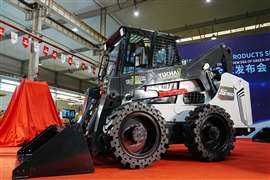Falsework & Formwork: problem solving
07 November 2012

Every construction job throws up problems which have to be overcome, and the challenges that face falsework and formwork companies can be particularly taxing – as a result of the climate or the specific requirements of the architect, for example.
Weather conditions are proving something of a challenge to German-based Meva on a Swiss site. The Alps in the canton of Glarus, said to be the most snowy in Switzerland, are the setting for a project to build Europe´s largest hydro power plant, known as Lintham 2015.
An underground pumped storage hydro power plant will pump water out of Lake Limmern back to Lake Mutt, which is 600m higher.
The project will increase the power output of the Linth-Limmern power plants from around 480 to 1,480MW. Lake Mutt will see a new concrete dam stretching 1km across the foot of the valley, increasing the lake’s storage capacity from 9 to 25 million m3. The natural level of Lake Mutt will grow from 2,446m above sea level to 2,474m.
A new system of caverns deep inside the Alps is being built at the foot of the present-day Lake Limmern dam. It will house turbines and transformers. The construction period will last around seven years.
The project is described as a huge technical and logistical challenge for all involved, including Meva’s formwork engineers. The schedule is tight because of the weather conditions – it snows even in early autumn – and there is virtually no space to move or store building material and heavy machinery.
As a result, the equipment has to be hauled from the base camp at 800m to the building sites at 1,700m and 2,500m, via a special cable car and an access tunnel with a funicular railway.
Concrete works are in progress on the inlet and outlet gallery on Lake Mutt. The 12m high walls are being poured using single and double-sided applications of the Meva support frame STB 450 and Mammut 350 wall formwork.
Meva said that exceptionally high concrete pressure required back anchoring instead of standard props. The underground caverns for the power plant equipment are 156m long, up to 30m wide and up to 53m high. There are challenges here too, with cramped conditions, and little storage space on the construction sites, especially inside the mountain.
Meva said that high concrete pressure and the need to move the formwork units from one pour to the next required considerable effort in planning and logistics to keep to the tight schedule.
Complex structures
In Moscow, Italian firm Pilosio was chosen by Flat & Co to supply formwork and floors for a major residential and commercial structure. Pilosio is supplying around 1,200m2 of P300 formwork and 2,000m2 of Slabform floors to the company which is engaged in constructing the structure in Odessa Street.
The building is composed of three towers around 85m high, and is made up of 26 floors, of which four are below ground, for residential and commercial use.
Each tower will be built around an elliptical core and the individual floors will be positioned around the axis, creating a twist from floor to floor.
Pilosio’s engineers have developed a design that involves the use of the P300 formwork, which has enabled the construction of the complex elliptical core.
P300 is a universal system of modular formwork that Pilosio said was suitable for all types of building site for the execution of vertical artefacts cast on-site.
Pilosio said the P300 panels were simple and robust, resistant to a maximum pressure of 60kN per m2.
Pilosio’s tailor-made design for the client involved the creation of monolithic slab flooring by means of the Slabform system, which it said enabled a high level of productivity since it allowed faster removal of formwork than traditional wooden systems. This made it possible to cast as many as three floors a month, rather than a single one, and to complete the entire complex in a little less than a year.
Slabform is an aluminium modular formwork system for the construction of cast floors on-site in monolithic or lightweight concrete. It is said to be completely industrialised formwork that does not require specialised labour for assembly.
The P300 is based on a 1,000 x 3,000mm base panel with what Pilosio described as a few simple accessories, from a quick connection block to allow extremely quick framework operations, removal and replacing framework, to a varnished frame and surface counter-cast in 18mm thick, high resistance, multilayered Finnish panels to ensure a high number of uses.
The coupling system, spaced every 1.5m2, is based on a P300 connecting block that ensures speedy assembly and perfect alignment of the formwork.
The company said the advantages of this system lay in the speed of assembly and dismantling, in the alignment and perfectly coplanar joining of the panels and in its simplicity of use in every situation – it claimed a single downward stroke with a hammer was enough to seal the block.
After the de-greasing and cleaning processes, the high resistance steel frame is varnished for immersion and drying in an oven at 130°C. The result is said to be a frame that is highly resistant to scratches and oxidation. The multilayered panel is 18mm thick with surface protection from phenolic film. It is made up of 13 layers of birch with protected, zero moisture absorption panel. The edges are protected with varnish and it can be used around 100 times per side.
The Slabform system is made up of a limited number of components which include high capacity supports of various sizes, aluminium beams of various measurements and panels of various sizes in aluminium with multi-layered covering.
Bespoke solution
Harsco Infrastructure provided a bespoke access solution to John Murphy & Sons (JMS) for a project in Maryport, Cumbria, UK. United Utilities contracted JMS to construct a major storm water handling facility to prevent storm surges entering the Solway Firth.
The access solution involved the use of modified mast-climbing work platforms. This idea was first used at another JMS site at Deephams in north London for Thames Water, and was adapted to suit the Maryport scheme.
The new 25m circular concrete tank has been built inside a secant piled wall and is 14.5m deep. Harsco’s mechanical access director, Cameron Reid, said, “The in-situ reinforced concrete walls of the tank would traditionally be built using scaffolding. However, this can historically prove expensive and difficult to manage inside the cramped excavation pit.
“Working with the civil engineering contractor, JMS, we developed the innovative use of mast climbers to enable the concrete formwork to be poured inside the excavation while at the same time providing full access to the walls of the shaft.”
Harsco provided six mast climbers for the project, each fitted with a special curved face that allowed the workforce direct access to the tank walls as they were being built.
JMS representative Aidan Kerrigan said, “The six mast climbers proved to be very flexible insofar as we were able to raise and lower them as we needed, so that several construction activities could progress simultaneously. Steelfixers were working at a higher level on one mast climber while joiners were erecting formwork at a lower level on another.
“This allowed us to work at a more rapid pace than would have been possible using traditional scaffolding.”
High rise projects
The high rise expertise of Doka was called upon for a skyscraper which will rise to 167m tall.
Designed by Italian architect Renzo Piano, it was commissioned by Italian bank Intesa Sanpaolo for its new headquarters. Contractor Rizzani de Eccher called on Doka for its know-how in highrise buildings and its automatic climbing formwork SKE50 plus for the core.
SKE50 plus is described as a crane-independent system for structures of any shape and height. Formworks and working platforms climb together as a unit, without using the crane. The hydraulic units remain anchored to the concrete at all times and allow a constant productivity for all the construction process.
In order to protect the poured slabs, the sideguard system XP was installed, as well as on the wheeling-out platforms. The building is scheduled to be completed in February 2013.
Paschal supported a large automobile manufacturer in Northern Germany when it expanded its factory capacities for engine components. The expansion of an existing production building by 1,500m² was accomplished with a mezzanine slab, and the contract was awarded to contractor Daume.
Tear-down work began in April 2011, requiring excavation work up to 3m deep. Piles and columns were built onto individual and strip footings. An individual footing measured 7m x 9m at a thickness of 1.60m. In total, 110 tons of steel and 500m³ C30/37 concrete were used. Modular universal formwork was employed as foundation formwork.
Paschal said the 60m long mezzanine slab was of particular interest for its shoring. The slab is supported every 16m by two 6m high round columns. A beam that is 1.40m in width, 1.90m in height and also 6m in length rests on these columns.
Paschal said that the “easily manipulated” modular formwork had the advantage that it could be adjusted to the construction site conditions with accuracy of within 1cm, without making gap adjustments on-site.
A total of 28 pre-fabricated beams rest on the beam as cross-members and support the slab. The pre-fabricated parts engage like a frame into the in-situ concrete beam at 50cm.
The lengthwise beam and all pre-fabricated elements were supported with GASS (great aluminium-shoring system). Paschal said that the GASS had the advantage of being able to support loads of up to 140kN per leg, while being made from aluminium, it was light and easy to handle and could be installed and removed quickly, reducing construction time.
Following this success, a second construction phase, similar to the first phase, has been undertaken.






